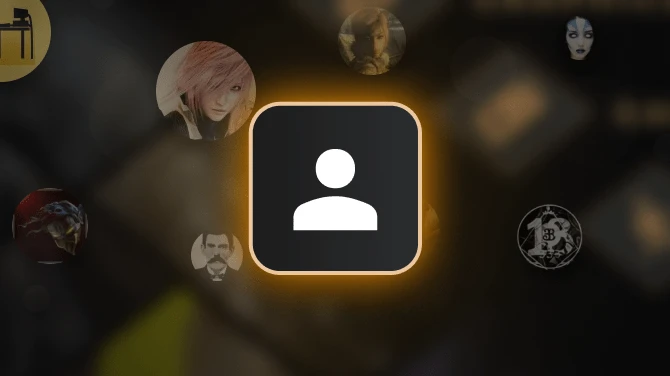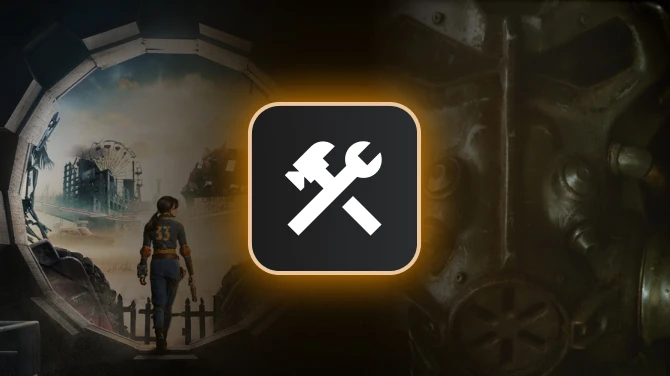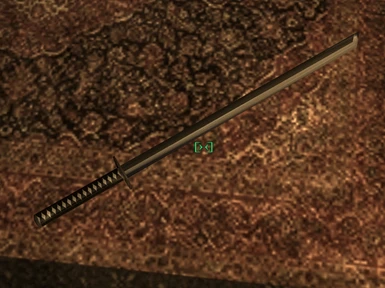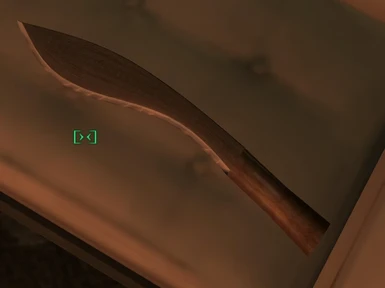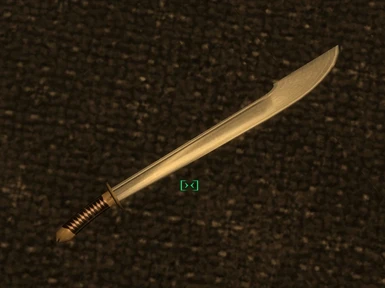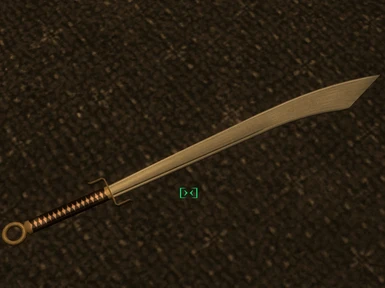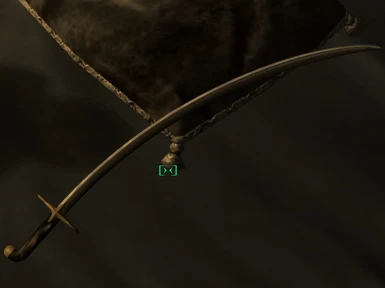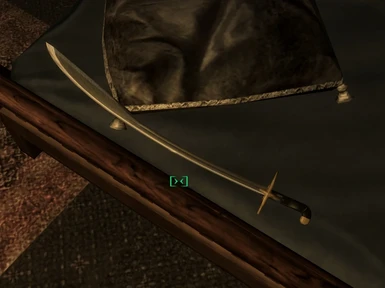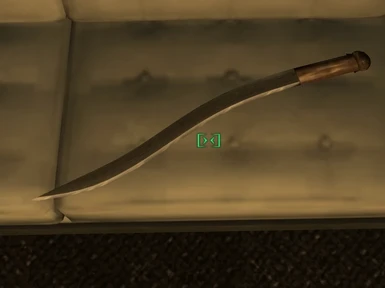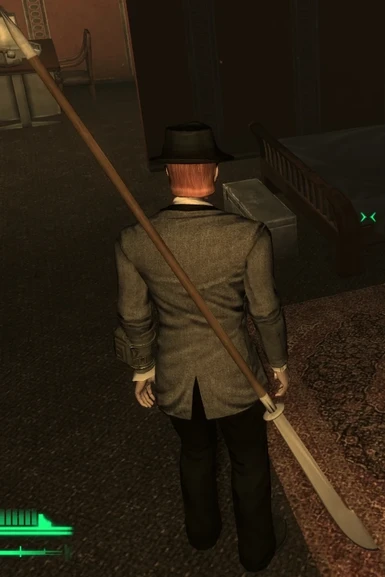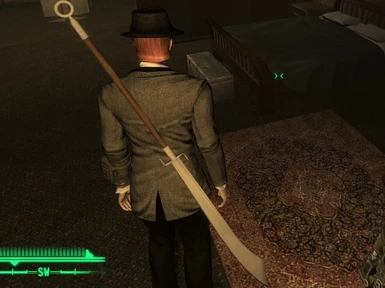WHAT IT DOES
It adds a Ninjato, 2 turkish blades, 1 persian blade, 1 Kukri, and 4 chinese blades. The blades are historical, but their models may be limited by my modelling skilly. The details are as follows.
1. A new sword, the Ninjato. ("Ninja sword.")
Ninjatos were _not_ katanas, though some were converted from katanas and many had a katana handle and handguard. They were straight, or only very slightly curved, they were shorter than a katana and the tip tended to be angular. It was a weapon designed for close quarters combat, and which could be used for both cutting and thrusting. But partially the lack of curve also came from the poorer forging techniques (the curvature is a result of differential tempering) and some of the really straight ones were little more than thin iron bars with an edge ground on them. This was somewhat offset though by the ninja's having more tools and tricks up their sleeve.
Per popular request (in the FO3 days) this one got its traditional silk-wrapped tsuka (grip.) Personally I'm sort of doubtful that it would survive 200 years in the ruins, but people seemed to want a better handle, so here it is.
2. A new sword, the Kilij. (Turkish Scimitar)
This is the Ottoman Empire 16'th century version of a scimitar, rather deeply curved and top-heavy. The sword is almost straight for the first half or so of the length, then curves more visibly along the distal half. It flares rather dramatically in width at about 30% from the tip.
Often the yelman (back of that flared tip) was sharpened too, though not always. The one I've included narrows to almost an edge there, but doesn't actually have an edge ground into that side.
It is primarily a slashing weapon, and quite deadly in that role. The sharp tip can technically be used for thrusting, but because its axis doesn't fall along the handle's axis, any thrusts will necessarily be weaker and less accurate than with a straight sword.
For a beautiful example of this design, see the sword of Suleiman the Magnificent. Though the one I've included is a more mundane soldier's sword, so don't ask for jewels on it ;)
3. A new sword, the Yatagan. (Turkish Sword)
The Yatagan is probably _the_ word that comes to mind when most people think "turkish sword". The design is supposedly the invention of the Ottoman general known as "Yatagan Baba", who gave his name to both the sword and the town he settled in. The design is however a variation of the native swords in the region, and can trace its history all the way back to the bronze age.
The Yatagan is actually curved _forwards_ to various degrees, i.e., exactly opposite from a sabre or asian sword, though most recurve backwards towards the tip. It is somewhat similar in that aspect to the ancient Greek Kopis, the Falcata, or some designs are actually reminescent of the ancient Egyptian/Canaanite Khopesh.
Like them, it is mostly a hacking sword, which is to say it handles somewhat like an axe. Piercing is possible, though like with most curved swords, it lacks either the accuracy or the strength of a straight sword in that role.
The weapon lacks any kind of a handguard, and actually a part of the hilt goes into the scabbard when sheathed. Where you'd normally expect a pommel, the hilt flares into two "ears", to prevent the sword from slipping out of the hand when swung.
Many ceremonial or parade Yatagans had ornate silver or ivory handles, with the decorations extending even over the lower part of the blade. On the other hand, many were simple combat blades with hilts made of wood, horn or bone. The one included is the latter kind.
The weapon included here, furthermore is a Janissary corps yatagan, which is to say it's shorter and lighter, designed to be a (very deadly) secondary weapon rather than the main armament.
4. A new sword, the Shamshir (the original Persian Scimitar.)
The Shamshir is the original Persian name for what is called a Scimitar in the west. It is a very curved blade, more so than almost any other type. It is similar to the Indian Talwar, except it has a narrower blade than the Talwar. Unlike the "scimitars" included in many video games, it does not flare at the tip, in fact it tappers to a point.
Its curvature makes it superb for slashing unarmoured opponents. Thrusting is technically possible, but the radical curvature makes it very inaccurate in that role, as well as very hard to put some strength behing the tip.
The one included here is mounted on a Turkish hilt, as historically many were.
5. A new sword, the Dao (Chinese Saber).
This is one of the many broad bladed backsword variants collectively known as a Dao. This was the weapon issued to footsoldiers (unlike the Jian, which was the longsword of the elites and nobles,) and considered to be the easiest to master.
The weapon is relatively top-heavy, and excellent at slashing and hacking, much like the European falchion or machette. The tip can technically be used for thrusting against lightly armoured foes too, but is useless at thrusting against any kind of metal armour.
Literally, the name literally means "knife" or "blade", so now you too can bring a knife to a gun fight ;)
6. A new sword, the Dadao (Chinese Big Saber).
Yet another of the many variants of the Dao, this time with a slightly longer blade and a longer handle which allows one-and-a-half hand and even two-hand techniques.
It was actually used in war as late as World War 2, against the Japanese. In fact, it was a standard issue weapon for soldiers of the Chinese nationalist army. (Though there were at least two different types of "Dadao" used by the army. This was the shorter handled version.)
In the game I left it one-handed, though, since I have another variant in mind for two-handed use.
7. A new polearm, the Pudao (somewhat similar to a glaive.)
Though literally called an "assault sabre" and often a "horse-cutter sword", it's actually an infantry polearm with 1.5 to 2m handle. As the second name suggests, it was used to cut the horses' legs off when charged by cavalry.
It's somewhat similar to the guan-dao (reclining moon blade), except it's lighter and has a thinner blade. (Though, make no mistake, the guan-daos weighing tens of kilos one sees in museums were either purely ceremonial, or used for tests of strength, not in combat. The combat ones were considerably lighter.)
The in-game model actually has a shorter pole than the real thing, because, well, a 2.5m (including the blade) weapon would be silly and extremely impractical in the game's confined spaces.
8. A new hybrid two-hander, the Zhanmadao (somewhat similar in role to european two-handers.)
The Zhanmadao was the original "horse-cutter blade" (in fact, its name means just that,) and it has a history stretching at least way back to the Song dynasty. Soldiers were trained to kneel and chop off a leg of the enemy horse, then finish off the rider.
I'm calling it a hybrid, because it looks like a short polearm, but it was used more like a two-hander than as a halberd. Well, in as much as you can even compare chinese fighting styles to the European ones. They were really very different beasts.
It is one of the weapons which showed the most variability across time and space. For example a Qing-dynasty regulation Zhanmadao looks _nothing_ like the same-name weapon 700 years earlier.
This weapon too was used in WW2 againts the Japanese and issued to soldiers. Confusingly enough, both this and the shorter-handled one were called Dadao at the time. (Presumably because Dadao means just "big blade".)
9. A new knife, the Nepalese Kukri.
The Kukri was the traditional weapon of the Gurkhas, and kept as an army-issued sidearm for the British Gurkha regiments.
It is forwards curved and relatively top-heavy, but very lightweight in any case. It is an excellent hacking weapon and not bad at stabbing either for a curved blade. The Gurkhas were known to behead their opponents with it, and it says something about the blade if it can cleave right through a human neck.
The one I've included is based on the Mark I British army model, with its more rounded curves, as opposed to the relatively abrupt bend in the back of the more recent models. Though the Mark III is also a close enough match.
HOW TO GET IT
I've given them all to Chet in Goodsprings to sell. None of them are cheap, though.
HOW TO INSTALL IT
Extract the archive, with directories, in your "fallout new vegas\Data" folder. Select it in the list of plugin files in the launcher.
HOW TO UNINSTALL IT
Delete the .esp file from your Data directory.
Delete the directory MExotic in both the Meshes and Textures directory.
CONFLICTS
It shouldn't conflict with anything, because it doesn't change anything that already exists in the game.
VERSION HISTORY
1.01:
Changed the textures
Increased the size of the kukri by about 25%
Increased the size of the yatagan by about 10%
Made the kukri faster, to compensate for the lower base damage
1.0:
First NV Release (somewhat on par with 1.7.1 for FO3, but with better shading)
It adds a Ninjato, 2 turkish blades, 1 persian blade, 1 Kukri, and 4 chinese blades. The blades are historical, but their models may be limited by my modelling skilly. The details are as follows.
1. A new sword, the Ninjato. ("Ninja sword.")
Ninjatos were _not_ katanas, though some were converted from katanas and many had a katana handle and handguard. They were straight, or only very slightly curved, they were shorter than a katana and the tip tended to be angular. It was a weapon designed for close quarters combat, and which could be used for both cutting and thrusting. But partially the lack of curve also came from the poorer forging techniques (the curvature is a result of differential tempering) and some of the really straight ones were little more than thin iron bars with an edge ground on them. This was somewhat offset though by the ninja's having more tools and tricks up their sleeve.
Per popular request (in the FO3 days) this one got its traditional silk-wrapped tsuka (grip.) Personally I'm sort of doubtful that it would survive 200 years in the ruins, but people seemed to want a better handle, so here it is.
2. A new sword, the Kilij. (Turkish Scimitar)
This is the Ottoman Empire 16'th century version of a scimitar, rather deeply curved and top-heavy. The sword is almost straight for the first half or so of the length, then curves more visibly along the distal half. It flares rather dramatically in width at about 30% from the tip.
Often the yelman (back of that flared tip) was sharpened too, though not always. The one I've included narrows to almost an edge there, but doesn't actually have an edge ground into that side.
It is primarily a slashing weapon, and quite deadly in that role. The sharp tip can technically be used for thrusting, but because its axis doesn't fall along the handle's axis, any thrusts will necessarily be weaker and less accurate than with a straight sword.
For a beautiful example of this design, see the sword of Suleiman the Magnificent. Though the one I've included is a more mundane soldier's sword, so don't ask for jewels on it ;)
3. A new sword, the Yatagan. (Turkish Sword)
The Yatagan is probably _the_ word that comes to mind when most people think "turkish sword". The design is supposedly the invention of the Ottoman general known as "Yatagan Baba", who gave his name to both the sword and the town he settled in. The design is however a variation of the native swords in the region, and can trace its history all the way back to the bronze age.
The Yatagan is actually curved _forwards_ to various degrees, i.e., exactly opposite from a sabre or asian sword, though most recurve backwards towards the tip. It is somewhat similar in that aspect to the ancient Greek Kopis, the Falcata, or some designs are actually reminescent of the ancient Egyptian/Canaanite Khopesh.
Like them, it is mostly a hacking sword, which is to say it handles somewhat like an axe. Piercing is possible, though like with most curved swords, it lacks either the accuracy or the strength of a straight sword in that role.
The weapon lacks any kind of a handguard, and actually a part of the hilt goes into the scabbard when sheathed. Where you'd normally expect a pommel, the hilt flares into two "ears", to prevent the sword from slipping out of the hand when swung.
Many ceremonial or parade Yatagans had ornate silver or ivory handles, with the decorations extending even over the lower part of the blade. On the other hand, many were simple combat blades with hilts made of wood, horn or bone. The one included is the latter kind.
The weapon included here, furthermore is a Janissary corps yatagan, which is to say it's shorter and lighter, designed to be a (very deadly) secondary weapon rather than the main armament.
4. A new sword, the Shamshir (the original Persian Scimitar.)
The Shamshir is the original Persian name for what is called a Scimitar in the west. It is a very curved blade, more so than almost any other type. It is similar to the Indian Talwar, except it has a narrower blade than the Talwar. Unlike the "scimitars" included in many video games, it does not flare at the tip, in fact it tappers to a point.
Its curvature makes it superb for slashing unarmoured opponents. Thrusting is technically possible, but the radical curvature makes it very inaccurate in that role, as well as very hard to put some strength behing the tip.
The one included here is mounted on a Turkish hilt, as historically many were.
5. A new sword, the Dao (Chinese Saber).
This is one of the many broad bladed backsword variants collectively known as a Dao. This was the weapon issued to footsoldiers (unlike the Jian, which was the longsword of the elites and nobles,) and considered to be the easiest to master.
The weapon is relatively top-heavy, and excellent at slashing and hacking, much like the European falchion or machette. The tip can technically be used for thrusting against lightly armoured foes too, but is useless at thrusting against any kind of metal armour.
Literally, the name literally means "knife" or "blade", so now you too can bring a knife to a gun fight ;)
6. A new sword, the Dadao (Chinese Big Saber).
Yet another of the many variants of the Dao, this time with a slightly longer blade and a longer handle which allows one-and-a-half hand and even two-hand techniques.
It was actually used in war as late as World War 2, against the Japanese. In fact, it was a standard issue weapon for soldiers of the Chinese nationalist army. (Though there were at least two different types of "Dadao" used by the army. This was the shorter handled version.)
In the game I left it one-handed, though, since I have another variant in mind for two-handed use.
7. A new polearm, the Pudao (somewhat similar to a glaive.)
Though literally called an "assault sabre" and often a "horse-cutter sword", it's actually an infantry polearm with 1.5 to 2m handle. As the second name suggests, it was used to cut the horses' legs off when charged by cavalry.
It's somewhat similar to the guan-dao (reclining moon blade), except it's lighter and has a thinner blade. (Though, make no mistake, the guan-daos weighing tens of kilos one sees in museums were either purely ceremonial, or used for tests of strength, not in combat. The combat ones were considerably lighter.)
The in-game model actually has a shorter pole than the real thing, because, well, a 2.5m (including the blade) weapon would be silly and extremely impractical in the game's confined spaces.
8. A new hybrid two-hander, the Zhanmadao (somewhat similar in role to european two-handers.)
The Zhanmadao was the original "horse-cutter blade" (in fact, its name means just that,) and it has a history stretching at least way back to the Song dynasty. Soldiers were trained to kneel and chop off a leg of the enemy horse, then finish off the rider.
I'm calling it a hybrid, because it looks like a short polearm, but it was used more like a two-hander than as a halberd. Well, in as much as you can even compare chinese fighting styles to the European ones. They were really very different beasts.
It is one of the weapons which showed the most variability across time and space. For example a Qing-dynasty regulation Zhanmadao looks _nothing_ like the same-name weapon 700 years earlier.
This weapon too was used in WW2 againts the Japanese and issued to soldiers. Confusingly enough, both this and the shorter-handled one were called Dadao at the time. (Presumably because Dadao means just "big blade".)
9. A new knife, the Nepalese Kukri.
The Kukri was the traditional weapon of the Gurkhas, and kept as an army-issued sidearm for the British Gurkha regiments.
It is forwards curved and relatively top-heavy, but very lightweight in any case. It is an excellent hacking weapon and not bad at stabbing either for a curved blade. The Gurkhas were known to behead their opponents with it, and it says something about the blade if it can cleave right through a human neck.
The one I've included is based on the Mark I British army model, with its more rounded curves, as opposed to the relatively abrupt bend in the back of the more recent models. Though the Mark III is also a close enough match.
HOW TO GET IT
I've given them all to Chet in Goodsprings to sell. None of them are cheap, though.
HOW TO INSTALL IT
Extract the archive, with directories, in your "fallout new vegas\Data" folder. Select it in the list of plugin files in the launcher.
HOW TO UNINSTALL IT
Delete the .esp file from your Data directory.
Delete the directory MExotic in both the Meshes and Textures directory.
CONFLICTS
It shouldn't conflict with anything, because it doesn't change anything that already exists in the game.
VERSION HISTORY
1.01:
Changed the textures
Increased the size of the kukri by about 25%
Increased the size of the yatagan by about 10%
Made the kukri faster, to compensate for the lower base damage
1.0:
First NV Release (somewhat on par with 1.7.1 for FO3, but with better shading)






